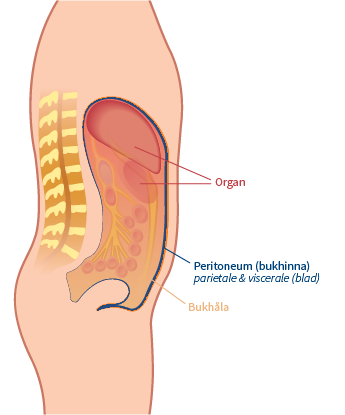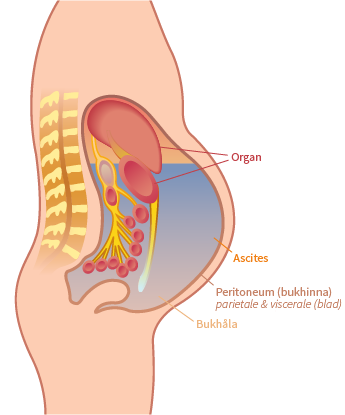Ascites (fluid in the abdomen)
Easily explained!
Short and simple
The most common causes of ascites
- Cancer
- Liver cirrhosis
- Heart failure
Symptoms of ascites
- Swelling in the abdomen
- Abdominal pain
- Nausea/vomiting, poor appetite
- Bloating
- Shortness of breath
Synonyms for ascites
- Fluid in the abdomen /abdominal fluid
- Fluid in the stomach
- Belly fluid
How to treat recurrent ascites
- One-time drainage (paracentesis / laparocentesis)
- Indwelling ascites catheter
Peritoneum (abdominal wall)
The peritoneum is a thin membrane in the abdomen, which is divided into two membranes, also known as layers. The parietal peritoneum is the name of the outer layer that covers the inside of the abdominal wall. The inner layer is called the visceral peritoneum and wraps around the internal organs located inside the intraperitoneal space.
The peritoneum has two main functions. Firstly, it protects the organs in the abdominal cavity. Secondly, it produces a lubricating fluid that allows the organs to move better.


What is ascites?
Ascites (abdominal fluid) is when fluid builds up in the abdominal cavity. As a result, the stomach visibly increases in size and you may experience symptoms such as a feeling of pressure in the stomach, pain, nausea, poor appetite, vomiting and shortness of breath.
Why does ascites occur?
Ascites can occur for a variety of reasons. Cancer, heart failure or inflammation of the intestine are examples of diseases that can cause ascites. Late-stage liver cirrhosis also causes an accumulation of fluid in the abdominal cavity as a typical symptom.

The biggest benefit is not having to go to the hospital several times a week. It takes a lot of time and you have to lie there sometimes for a day in addition to be driven back and forth between the ward and the X-ray. Even symptom relief: Now I can not only drain myself, I can even decide freely when I want to drain based on symptoms I am feeling. This way I avoid the bloated feeling and the breathing feels easier.
– Patient from Uppsala, ascites (heart failure) –
How do you treat ascites?
In addition to treating the disease that causes ascites, depending on what is causing the fluid, the following therapies can be used to treat recurrent ascites.
One-time drainage (paracentesis/laparocentesis).
A one-time drainage is a procedure that is often performed in an outpatient clinic. If you need to remove a lot of fluid, you may also have to be admitted to a hospital. In a paracentesis, the fluid is removed with a syringe through a cannula.
Indwelling ascites catheter
At ewimed, we recommend immediate implantation of an indwelling ascites catheter in cases of recurrent ascites.
One advantage of an indwelling catheter is that the patient does not have to go to the hospital repeatedly for the doctor to puncture and reinsert a catheter. The patient has more time at his or her disposal, as the fluid can be drained at home without the need for a doctor to be present. Thus, the patient’s mobility and quality of life increases.
Other benefits of an indwelling catheter include fewer hospital stays and a low risk of infection or complications (as supported by scientific studies).
Brief overview of the benefits of our indwelling catheters
- enables independent, fast and patient-safe drainage at home.
- no further hospitalisation due to the fluid
- simple and easy to use
- no repeated, painful procedures
- a single minimally invasive procedure to implant the catheter
- highest patient safety thanks to the unique connection to the drainage set
- increased mobility and independence for you as a patient
- reduced risk of infection
Do you have any questions?
Contact us or browse through a selection of our frequently asked questions (FAQs).